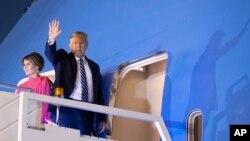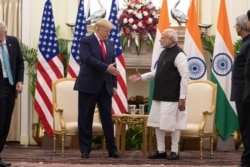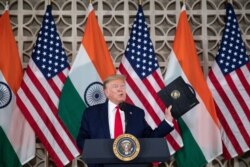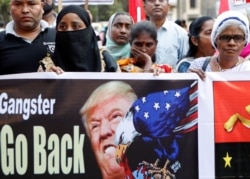U.S. President Donald Trump has wrapped up a spectacle-filled visit to India, where he was greeted by massive crowds in a “Namaste Trump” event, took in the grandeur of the Taj Mahal and declared U.S.-India relations to be “stronger than ever before.”
The president stayed on script on a visit that was designed to accentuate the positive and personal dimensions of the U.S.-India relationship.
“We’ll always remember that magnificent welcome the citizens of your home state showed us upon arrival,” Trump said to Indian Prime Minister Narendra Modi, calling it a “profound expression of strength and of real love.”
The visit was marred, however, by violent street protests of rival Hindu and Muslim groups demonstrating over a new citizenship law that led to the deaths of at least 10 people in two days of clashes, the Associated Press reported. Another 186 people were injured, including police and protesters.
India's capital has been rocked by violence and demonstrations since parliament approved a new citizenship law in December that would allow a speedy naturalization process for many foreign-born religious minorities but not Muslims. Trump said he was aware of the protests but did not discuss it with Modi.
"I don't want to discuss that," Trump told reporters. "I want to leave that to India and hopefully they're going to make the right decision for the people."
during Trump's visit, the two countries did not manage to bridge differences over a bilateral trade deal, but observers said the president benefited from 100,000 people of an important country cheering for him, on his first major foreign trips since being acquitted of impeachment charges in the U.S.
The visit “is an answer to critics who accuse him of diminishing America’s power and prestige abroad,” Thomas Schwartz, a historian of U.S. foreign relations at Vanderbilt University, said.
“It also does not hurt that this is a non-white country,” Schwartz said.
A video by a self-proclaimed fan “to celebrate Trump’s India visit” went viral after a retweet by the president. The meme shows Trump on a horse leading an army, wielding a sword and killing enemies.
Indian Americans
Immigrants from India are the second-largest foreign-born group in the U.S. There are estimated to be nearly 4 million Indian Americans, many affluent and highly educated voters.
“Whether it is as professionals or students, the Indian diaspora in the U.S. has contributed the most to furthering these [U.S.-Indian] relations,” Modi said during Trump’s visit.
Modi said he also wants to have further conversations on the diaspora's contributions to the U.S. Social Security program as part of the trade talks. He was referring to Indians with H-1B, or non-immigrant, visas that allow American companies to employ graduate-level workers in specialty occupations.
“For Delhi, the issues of India’s skilled workers (holders of L-1 but especially H-1B visas) is important,” said Aparna Pande, director of the Hudson Institute's Initiative on the Future of India and South Asia.
These workers pay taxes in the U.S. and contribute money toward the U.S. Social Security system, the benefits of which they will not be able to enjoy unless they remain in the United States.
“India would like any trade deal to also cover and find a way out for this issue,” Pande said.
Trump is unlikely to agree to this demand but publicly airing the differences over issues important to the Indian diaspora scores political points for Modi.
“Prime Minister Narendra Modi’s political party, the Bharatiya Janata Party, is well-organized here in the United States, and will be quite pleased to see a positive visit,” said Richard Rossow, the Wadhwani chair in U.S.-India Policy Studies at the Center for Strategic and International Studies.
Just 19% of Indian Americans identify as Republican, and only 16% supported Trump in 2016. But in what many expect will be a tight race for reelection this year, the president is looking for political allies.
“A demonstrated affection for India and for Modi can help divert attention away from the Trump administration’s policies that have limited immigration, and scared Indian Americans,” sociologist Pawan Dhingra said. “Most will still not like Trump even after this, but they might not be as motivated to vote against him the more that they see India’s interests as tied to him.”
It would be difficult to quantify the domestic political impact of the visit in the immediate term. "This is certainly a political experiment," Rossow said. "We cannot be certain President Trump’s politically charged visit to India will shore up support for his re-election."
While analysts expect that the trip will unlikely be a game-changer in the Indian-American vote in 2020, there may long term benefits in focusing on the community.
“The Republican party is probably looking over the horizon,” said Joshua White, South Asia Studies professor at the Johns Hopkins University School of Advanced International Studies. “States such as Texas are likely to be increasingly competitive in future election cycles, and so it makes sense as a long-term investment to court Indian Americans.”
Trump organization portfolio
Trump’s India trip comes at a time when the country is experiencing an economic slowdown with economists warning of a “major recession.” The slump is expected to continue, with the International Monetary Fund recently slashing India’s growth forecast for this year by 1.2 percentage points to 5.8%.
India has the most Trump-branded properties outside of North America but the economic woes have left the country’s real estate market struggling and the Trump brand is no exception. The New York Times reported that the Trump family’s partners in Pune have stopped attempting to sell half of the luxury apartments in the complex.
While the president did not publicly mention his family business during his trip, the visit generates more conflict-of-interest questions about mixing presidential duties with personal gain.
“The president has shown a longstanding disregard for ethical norms, and could have done far more to insulate himself from the appearance of impropriety with respect to his holdings in India and elsewhere,” White, of Johns Hopkins, said.
The Indian projects were negotiated before Trump was elected and the Trump Organization has vowed that there would be “no new foreign deals” while the president is in office. In 2018, Donald Trump Jr., executive vice president of the Trump Organization, went on a business trip to promote the family’s real estate brand across India. He generated more than $15 million in real estate sales.
Trump has denied allegations of violations of the emoluments clause of the Constitution that prohibits officials from receiving gifts from foreign actors.






























